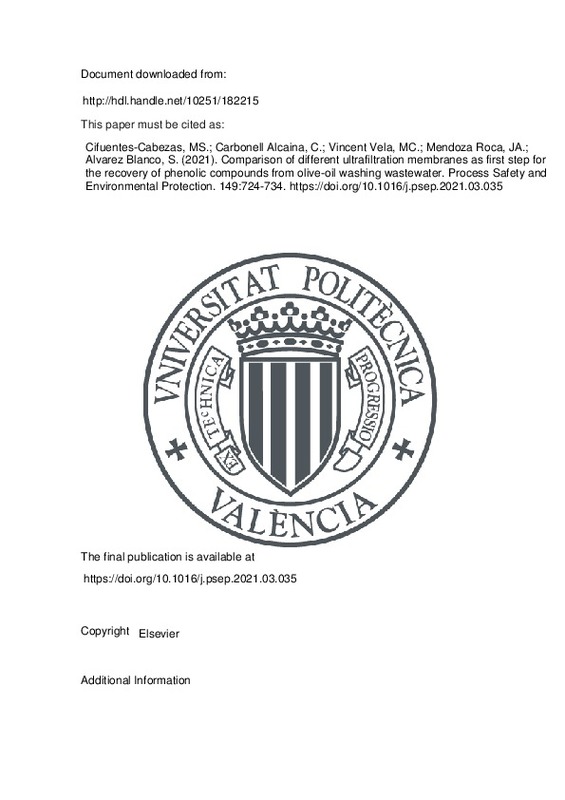JavaScript is disabled for your browser. Some features of this site may not work without it.
Buscar en RiuNet
Listar
Mi cuenta
Estadísticas
Ayuda RiuNet
Admin. UPV
Comparison of different ultrafiltration membranes as first step for the recovery of phenolic compounds from olive-oil washing wastewater
Mostrar el registro sencillo del ítem
Ficheros en el ítem
| dc.contributor.author | Cifuentes-Cabezas, Magdalena Soledad
|
es_ES |
| dc.contributor.author | Carbonell Alcaina, Carlos
|
es_ES |
| dc.contributor.author | Vincent Vela, Maria Cinta
|
es_ES |
| dc.contributor.author | Mendoza Roca, José Antonio
|
es_ES |
| dc.contributor.author | Alvarez Blanco, Silvia
|
es_ES |
| dc.date.accessioned | 2022-04-27T18:05:56Z | |
| dc.date.available | 2022-04-27T18:05:56Z | |
| dc.date.issued | 2021-03 | es_ES |
| dc.identifier.issn | 0957-5820 | es_ES |
| dc.identifier.uri | http://hdl.handle.net/10251/182215 | |
| dc.description.abstract | [EN] The production of olive oil generates wastewater with a high organic load and toxicity due to the high concentration of phenolic compounds. In recent years, the study on the treatments of these waters has been intensified together with the search for a process to recover these phenolic compounds due to their great antioxidant potential. All this with the aim of implementing the concept of circular economy. In this study, four different organic ultrafiltration membranes were evaluated in order to recover the phenolic compounds present in olive oil washing wastewater (OOWW) from an oil mill in the Valencian Community (Spain). The tested membranes differ in materials and molecular weight cut-off (MWCO): two permanently hydrophilic polyethersulfone (PESH) membranes with MWCO of 4 and 50 kDa, respectively, one polyethersulfone (PES) membrane with a MWCO of 5 kDa and a regenerated cellulose acetate (RCA) membrane with a MWCO of 10 kDa. Transmembrane pressure (TMP) and crossflow velocity (CFV) were varied from 1 to 3 bar and from 1.5 to 3.4 m/s, respectively. The effectiveness of the different membranes and operating conditions were evaluated comparing the permeate flux and the rejection of chemical oxygen demand (COD) and total phenolic compounds (TPhs). The membranes with lower MWCO showed stable permeate fluxes without significant changes over time, while the 50 kDa membrane showed a gradual decrease, without achieving a stable flux. Low rejection of phenolic compounds was observed in all cases, while the rejection of COD varied between 19.5 % and 62.9 % depending on the membrane and operating conditions tested. Except for the 50 kDa PESH membrane, initial permeability recovery greater than 95 % was achieved with a 35 °C water rinse, indicating that membrane fouling was not severe. Since the aim was to recover the TPhs in the permeate stream and separate them from the organic matter, the 5 kDa PES membrane at 2 bar and 2.5 m/s was considered to be the best option. At those conditions a stable permeate flux of 40 L/h·m2 was obtained, while the lowest TPhs rejection was observed (8.01 %) with a high COD rejection (61.18 %). | es_ES |
| dc.description.sponsorship | The authors acknowledge the financial support from the Spanish Ministry of Economy, Industry and Competitiveness through the project CTM2017-88645-R and The European Union through the Operational Program of the Social Fund (FSE). | es_ES |
| dc.language | Inglés | es_ES |
| dc.publisher | Elsevier | es_ES |
| dc.relation.ispartof | Process Safety and Environmental Protection | es_ES |
| dc.rights | Reserva de todos los derechos | es_ES |
| dc.subject | Olive oil washing wastewater | es_ES |
| dc.subject | Phenolic compounds | es_ES |
| dc.subject | Separation | es_ES |
| dc.subject | Ultrafiltration | es_ES |
| dc.subject.classification | INGENIERIA QUIMICA | es_ES |
| dc.title | Comparison of different ultrafiltration membranes as first step for the recovery of phenolic compounds from olive-oil washing wastewater | es_ES |
| dc.type | Artículo | es_ES |
| dc.identifier.doi | 10.1016/j.psep.2021.03.035 | es_ES |
| dc.relation.projectID | info:eu-repo/grantAgreement/AEI/Plan Estatal de Investigación Científica y Técnica y de Innovación 2013-2016/CTM2017-88645-R/ES/IMPLEMENTACION DE TECNOLOGIA DE MEMBRANAS PARA LA VALORIZACION DE LOS COMPUESTOS FENOLICOS PRESENTES EN LAS AGUAS RESIDUALES DE LA INDUSTRIA DE PRODUCCION DE ACEITE DE OLIVA/ | es_ES |
| dc.relation.projectID | info:eu-repo/grantAgreement/GENERALITAT VALENCIANA//ACIF%2F2018%2F166//AYUDA PREDOCTORAL GVA-CIFUENTES CABEZAS. PROYECTO: RECUPERACION DE POLIFENOLES DE EFLUENTES DE ALMAZARA MEDIANTE PROCESOS DE MEMBRANA Y TRATAMIENTO BIOLOGICO DE LAS CORRIENTES DE RECHAZO/ | es_ES |
| dc.rights.accessRights | Abierto | es_ES |
| dc.contributor.affiliation | Universitat Politècnica de València. Departamento de Ingeniería Química y Nuclear - Departament d'Enginyeria Química i Nuclear | es_ES |
| dc.description.bibliographicCitation | Cifuentes-Cabezas, MS.; Carbonell Alcaina, C.; Vincent Vela, MC.; Mendoza Roca, JA.; Alvarez Blanco, S. (2021). Comparison of different ultrafiltration membranes as first step for the recovery of phenolic compounds from olive-oil washing wastewater. Process Safety and Environmental Protection. 149:724-734. https://doi.org/10.1016/j.psep.2021.03.035 | es_ES |
| dc.description.accrualMethod | S | es_ES |
| dc.relation.publisherversion | https://doi.org/10.1016/j.psep.2021.03.035 | es_ES |
| dc.description.upvformatpinicio | 724 | es_ES |
| dc.description.upvformatpfin | 734 | es_ES |
| dc.type.version | info:eu-repo/semantics/publishedVersion | es_ES |
| dc.description.volume | 149 | es_ES |
| dc.relation.pasarela | S\432142 | es_ES |
| dc.contributor.funder | GENERALITAT VALENCIANA | es_ES |
| dc.contributor.funder | AGENCIA ESTATAL DE INVESTIGACION | es_ES |







![[Cerrado]](/themes/UPV/images/candado.png)

